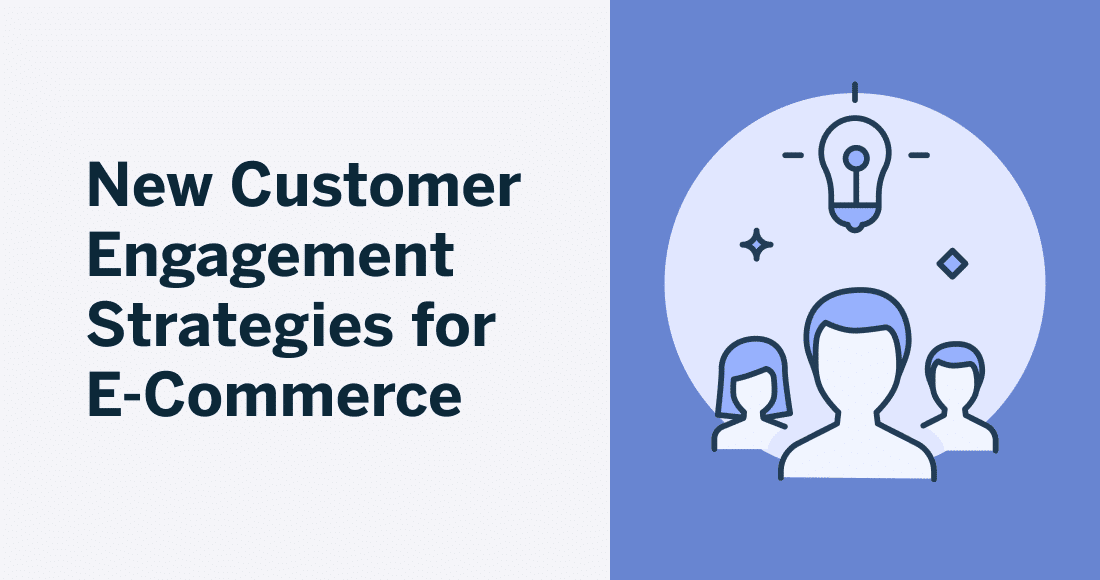The rapid shifts in consumer preferences, along with emerging channels throughout the past several years, have ushered in a new era of customer engagement.
Today’s customer could begin their journey with a brand at any touchpoint. Then, they’ll expect their experience with the brand to be consistent and seamless, even as they move back and forth between channels. What’s more, they’ll want the experience to be uniquely tailored to their individual wants and preferences — so engaging them with a cookie-cutter approach won’t cut it.
This evolution puts pressure on e-commerce marketers to either adapt their customer engagement marketing techniques to keep up with their customers… or lose out to the competitors who remain ahead of the curve. Those who know the formula for a winning customer engagement strategy can expect to experience:
- Increased customer growth
- Improved customer loyalty and lifetime value
- Greater revenue and business outcomes
Let’s look at 5 customer engagement strategies your e-commerce brand should be using now to ensure continued growth and revenue for the future.
1. Personalized Recommendations
Personalization is table stakes for any successful customer engagement strategy. This is especially true for e-commerce brands who have a lot of customer data available, and with the right technology and know-how, can leverage that data for revenue-driving personalized customer engagement.
Importance of Personalization in E-Commerce
Why is personalization important for e-commerce brands? Here are three reasons:
- Personalized customer experiences positively influence buyer behavior. Brands that can tailor their content to the individual are more likely to win more customers and keep them longer, with 76% of consumers stating they are “more likely to consider purchasing from brands that personalize” and 78% stating they are “more likely to make repeat purchases” from those same brands, according to McKinsey.
- Personalization reduces churn and increases loyalty. The more individualized your content is, the more impactful it will be for the customer, which ultimately increases the affinity they have toward your brand. According to Forbes, brands that used personalized offers experienced a “75% reduction in churn.”
- Personalized customer engagement leads to greater revenue and business outcomes. Not only does personalization make for a better customer experience, but it leads to better outcomes for businesses. McKinsey reveals that the fastest growing companies are driving “40% more of their revenue from personalization than their slower-growing counterparts.”
Utilizing Data for Customized Product Recommendations
Customers are looking for meaningful engagement. That is, they want to feel that the brands they engage with understand them as an individual. Customized product recommendations — rather than one-size-fits-all recommendations — go a long way in conveying that deeper understanding.
To bolster your personalization efforts, utilize customer, product, and sales data to create more relevant product recommendations for each and every customer. Whenever possible, incorporate data-driven personalization into any of your automations that feature product recommendations.
Implementing AI-Driven Personalization
Personalization yields the best returns when it’s highly relevant and when it can be delivered at scale. AI-driven personalization accomplishes both.
When given the right data (and when it’s properly organized and unified), AI is able to reveal patterns from that data and determine customer behavior with incredible accuracy. This takes your marketing from reactive to proactive, and ensures that your personalized offers are maximally relevant. Even better, AI allows you to deliver this high degree of hyper-relevant personalization at scale, even as your business grows.
2. Interactive Content and Visuals
In marketing we often talk about “engaging” with your customers — but does your content actually allow for engagement?
Consider what elements you can incorporate into your content to make it more engaging and interactive for customers.
Engaging Customers with Interactive Elements
When a customer visits a brick-and-mortar retailer, they can interact with the products in a more hands-on way. E-commerce brands benefit by simulating that experience as closely as possible with their online store. Offer customers the opportunity to “explore” your products by leveraging high-quality images, 360-degree product views, videos, and more.
Other great interactive tools include chatbots, live chat, and virtual stylists. Give customers the opportunity to learn about products, get advice on how to use products, or get customized recommendations through the use of live chat, chatbots, or virtual stylists on your website.
Importance of High-Quality Visuals in E-Commerce
Looks matter… at least, they do when it comes to how you present your products in your e-commerce store.
Use the highest quality visuals possible when showcasing your products. Customers want to know exactly what they are buying before they buy it, and high-quality visuals allow them to see nuances, particular details, or other quality indicators that make your product worthy of their purchase.
Leveraging Videos and 360-Degree Product Views
A picture is worth a thousand words. But a video is worth… who knows, a billion words? Videos can provide an incredibly engaging experience for customers, as it allows them to see a product in a three-dimensional way, rather than a flat image on their screen. This is the closest approximation to picking up a product off the shelf and examining it while in a physical store.
If you aren’t able to create videos to showcase each and every product at scale, 360-degree product views can offer a similar benefit. Both options elevate the customer’s experience and ability to explore your product — making it a strong component for successful e-commerce customer engagement.
3. Seamless Omnichannel Experience
With more and more digital channels emerging, today’s customers have an abundance of choice when it comes to connecting with the brands they love.
From the brand’s point of view, each channel offers its own distinct benefits and features. However, from the customer perspective, it doesn’t matter if they’re engaging through a brand’s website, mobile device, retail app, SMS, or even mobile wallet — it’s all one complete experience.
To create a more consistent customer journey, brands should strive for seamless omnichannel customer engagement.
Understanding the Omnichannel Approach
You’ve probably heard of multi-channel, cross-channel, and omnichannel marketing. These are sometimes used interchangeably, but in fact, there are key differences.
A multi-channel marketing approach involves the use of multiple channels, but they might not necessarily be connected, which means a customer might have a totally different brand experience depending on the channel they choose.
Cross-channel marketing is a step up, as some channels — say email and web — may be connected. But other channels like mobile in-app, SMS, or even in-store (if you’re a retailer with physical stores) might not be connected. This leaves brands at risk for creating disjointed customer experiences.
Omnichannel marketing, however, focuses on the complete customer journey, rather than individual channels. With an omnichannel approach, all data and channels are unified so that customers will have a seamless, continuous brand experience, regardless of channel.
4. Social Media Engagement
E-commerce brands need to fight to keep themselves front-and-center of their customers’ attention. One of the best ways to do that is through social media engagement. This makes social media an integral part of a successful e-commerce customer engagement strategy.
Leveraging Social Media for Brand Awareness
Because of their vast reach, social media platforms enable brands to connect with new customers. Your brand’s niche and audience may dictate where you choose to be most active, but you’ll want to consider all the major platforms like Facebook, Instagram, and LinkedIn.
Not only can you use these platforms to reach customers via targeted ads, but you can also encourage customers to engage in dialog with your brand, share their experiences, and promote their own user-generated content that enhances your brand’s visibility.
Creating Engaging Content
Social media may help you connect with more customers, but you’re not the only fish in the sea. Lots of brands are vying for your customers’ attention, so you’ll need to create engaging content that helps your brand rise above the noisy din.
Use visually appealing graphics, engaging videos, and eye-catching art that showcase your brand’s personality, while also conforming to a consistent brand image that customers can readily identify.
Responding to Customer Queries and Feedback
If customers take the time to engage with your brand via social media, don’t ignore them! Respond to customer queries in a timely, helpful way to encourage goodwill. If customers leave feedback about your brand — positive or negative — follow up appropriately and encouragingly. If you have an unhappy customer talking about your brand, take the time to address their concern.
This is equally true for customer reviews on your website. If you provide a forum for customer reviews (as you should), be responsive to the post-purchase feedback customers leave. Thank them for positive reviews, and respond with concern and attention to negative reviews, along with a willingness to fix any problem that led to the negative experience.
5. Customer Loyalty Programs and Incentives
Building long-lasting customer loyalty should be a top priority for every marketer — and e-commerce marketers are no exception. That’s why loyalty programs and loyalty-building incentives should be the cornerstone of a successful e-commerce customer engagement strategy.
Building Customer Loyalty Through Reward Programs
A good way to keep customers happy is by providing value. What do they get in exchange for shopping with your brand specifically? Rewarding them for their continued patronage ensures they feel appreciated and will keep coming back. A well-designed reward program increases customer satisfaction, and also creates more opportunities to engage with customers over time to extend their journey with your brand.
Offering Exclusive Discounts and Incentives
Exclusive discounts and incentives serve as powerful methods of engaging customers — especially when personalized. By offering loyal customers personalized, relevant offers and incentives, you can differentiate your brand from competitors.
Consider offering customers personalized discounts or coupons, limited edition products, or access to special events. These incentives not only increase customer loyalty but also empower customers to become brand advocates, helping attract new customers through positive word-of-mouth.
Monitoring and Measuring Loyalty Program Effectiveness
Your loyalty efforts should ultimately lead to increased customer retention, customer lifetime value, and revenue. To determine if you’re succeeding, you’ll need to monitor and measure your loyalty program effectiveness.
One way to do this is by gathering customer feedback through surveys, or analyzing behavioral insights from your customers — for example, are they redeeming rewards? Can you determine which incentives drive the most engagement?
A customer engagement solution with built-in analytics and reporting can answer those questions, and also tell you the efficacy of your loyalty-specific marketing campaigns and whether they’re generating revenue. This kind of insight will help you improve and refine your strategy over time.
Emarsys Helps You Win the E-Commerce Game
To provide the best e-commerce experience for your customers, you’ll need to step up your e-commerce marketing game.
This article offered five components that are essential to shore up your e-commerce customer engagement strategy. With a winning strategy in place, you can increase customer growth, improve customer loyalty, and drive greater revenue for your business.
But there’s another secret weapon that will bolster your e-commerce strategy: having the right customer engagement solution. With Emarsys, you can personalize your customer’s entire journey across any touchpoint, from online to mobile and back.
Watch this demo to see how top e-commerce brands use Emarsys to deliver the highly personalized omnichannel experiences that satisfy customers and accelerate business outcomes.












